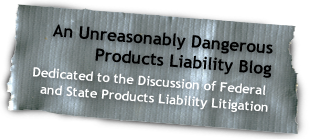You know you’re in trouble as defense counsel when the appellate court’s opinion starts with the sentence: “[The Plaintiff] has suffered a miserable ordeal since she had elbow surgery. ” That can only suggest that reading the court’s ruling will be a miserable ordeal for the defendant. So begins the opinion in last week’s Primiano v. Cook
, — F.3d —-, 2010 WL 788906 (9th Cir. March 10, 2010) [PDF]. Analyzing the admissibility of expert medical testimony at the summary judgment stage, the Ninth Circuit reversed the ruling of the trial court, which had excluded the Plaintiff’s medical expert and granted the defendants’ motion for summary judgment.
The Plaintiff, a 36 year old woman, suffered a fall in her kitchen, broke her right elbow, and ultimately required elbow replacement surgery. Her surgeon used an artificial elbow manufactured by the Howmedica Osteonics Corporation. Apparently, during the surgery, the surgeon realized that one of the component parts of the artificial elbow was intended to be used for a left elbow, not a right elbow. He then contacted a representative of Howmedica, who indicated that the component part was symmetrical, equally functional, and thus, able to be used for the surgery on the Plaintiff’s right elbow with only minor modifications. Following the surgery, all seemed to be well initially, but the Plaintiff ultimately experienced difficulties with the elbow replacement and required four additional surgeries, including the removal and replacement of the original artificial joint. Subsequent analysis revealed that the original artificial elbow had excessive wear. She then sued Howmedica, as the manufacturer of the device, its parent company, a Howmedica sales representative, and her surgeon under various theories of recovery, including products liability (the only cause of action at issue on the appeal). The suit was heard by the Honorable James C. Mahan of the U.S. District Court for the District of Nevada.
Noting that the prosthesis had been “malaligned,” the defense experts also argued that the life of the device would be limited due to the Plaintiff’s relative youth, level of activity, and her pre-existing rheumatoid arthritis. (Young people wear out artificial joints more quickly than older people, they said.). The district court excluded the testimony of the Plaintiff’s expert, Dr. Arnold-Peter Weiss, who had opined that “the polyethylene bushing had worn through in less than eight months, ‘not a usual or expected circumstance.'” The district court appeared concerned by the fact that Dr. Weiss had neither seen nor spoken with the Plaintiff as well as the fact that he could testify that the device failed but not why it did so. With no expert testimony supporting the Plaintiff’s case, the court granted the defendants’ motion for summary judgment. On appeal, the Ninth Circuit addressed the application of Federal Rule of Evidence 702 and Daubert to the testimony of expert physician witnesses. Analyzing the background, qualifications, and testimony of Dr. Weiss, the Ninth Circuit noted that they “[left] room for only one conclusion regarding its admissibility. It had to be admitted.” In so doing, the court noted:
Nevada law establishes that “those products are defective which are dangerous because they fail to perform in the manner reasonably to be expected in light of their nature and intended function.” In Nevada, a plaintiff need not “produce direct evidence of a specific product defect [or] negate any alternative causes of the accident.” An “unexpected, dangerous malfunction” suffices. Since Dr. Weiss, with a sufficient basis in education and experience, testified that the artificial joint “fail[ed] to perform in the manner reasonably to be expected in light of [its] nature and intended function,” that was enough to assist the trier of fact. He did not have to know why it failed.
The district court’s other concerns, that Dr. Weiss never saw or talked to Ms. Primiano, and there was no publication supporting his opinion that the device failed extraordinarily early, might be useful to the jury as impeachment, but neither furnished an adequate basis for excluding his opinion. What he most needed to see was what was inside her arm, not outside it, and he did. He saw the x-rays. He also saw the polyethylene from the implant installed in Primiano’s first surgery. As for lack of a publication backing his opinion up, Daubert offers several reasons why an opinion unsupported by peer-reviewed publication may be admissible, and Dr. Weiss furnished another one: that the phenomenon is so extraordinary that the specialists who publish articles do not see it in their practices.
(Emphasis added).
The Ninth Circuit then reversed the trial court’s granting of the defendants’ motion for summary judgment. An interesting result, as the opinion suggests that an expert who has never examined – or presumably even met – an injured Plaintiff can create a fact issue on summary judgment in a products liability action by claiming that a medical device failed too early without articulating why it did so. The district court had noted that evidence of rapid wear did not necessarily make the device defective. The defense experts did offer an explanation for the wear of the device, namely that devices tend to wear far more quickly when placed in the joints of younger – and presumably, more active – patients. Further, the defense pointed to the fact that this Plaintiff suffered from rheumatoid arthritis which further contributed to the wear. Thus, while the defense posited a specific reason for the rapid wear of the device, the Plaintiff’s expert simply offered the conclusion that the device should have lasted longer than it did. That is now enough to defeat summary judgment. (Interestingly, the Plaintiff did not sue the surgeon for malpractice but only as an agent of the manufacturer of the artificial elbow).














